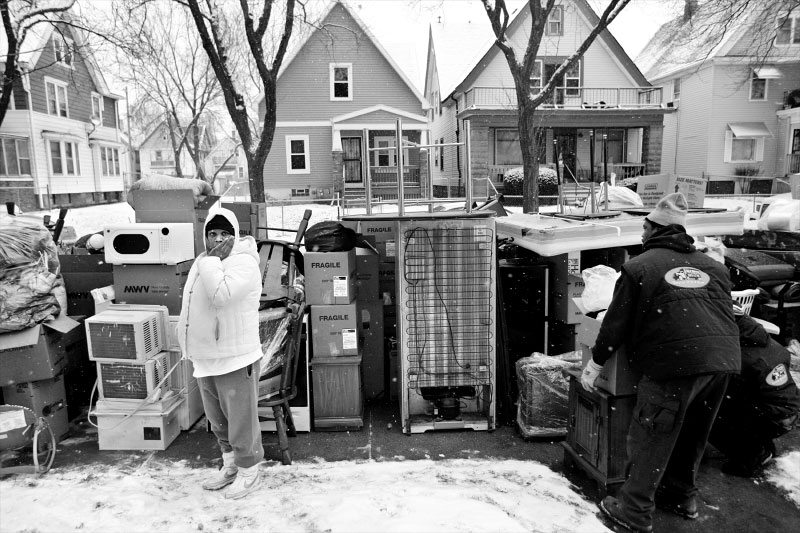Opening April 14, Evicted will be free for all visitors

WASHINGTON, D.C.—Beginning April 14, the National building Museum presents Evicted, a new exhibition that brings visitors to the intimate painful process of chronic eviction. Inspired by Matthew Desmond’s Pulitzer Prize-winning book, the exhibition presents new data developed by Desmond’s Eviction Lab, and uses original photography and audio interviews to examine the reasons for and fallout from eviction. Evicted is open through May 19, 2019 and will have free admission during its entire run.
Evictions used to be rare. But today, incomes for poor, renting families have remained stagnant, while housing costs have soared. More than 11 million Americans are extremely low-income renters: they work, but do not make enough money to pay rent in their housing market. The federal government does not fill this gap. In fact, 75% of qualified families do not receive federal housing aid, and low-income families face a shortage of affordable housing in almost every single county in the country.
Eviction is not just about the loss of private space and possessions. It often leads to a spiral of hard times, affecting everything from physical and mental health, to job performance and school stability. Landlords hesitate to rent to those with eviction records, or charge them extra money, causing a devastating negative feedback loop. Crimes go unreported as tenants fear penalization from nuisance ordinances. Children switch schools too often to make friends or be noticed and helped by teachers; neighbors cannot develop bonds; personal belongings are left in storage or out on the street.
Tenants rarely see an advantage to fighting their case in court, where they have no right to an attorney. In many housing courts, most landlords are represented by counsel, while most tenants are not. Landlords, who have paid for attorneys and gone through a sometimes arduous process to gather paperwork and wait the requested amount of time, almost always have the upper hand. In fact, often tenants do not even show up—whether because they cannot get the time off work or because they see no benefit to their appearance.
“Until recently, we simply didn’t know how immense this problem was, or how serious the consequences,” said Matthew Desmond, author, Evicted: Poverty and Profit in the American City; and professor of sociology, Princeton University. “Eviction does not simply drop poor families into a dark valley, a trying yet relatively brief detour on life’s journey. It fundamentally redirects their way, casting them onto a different, and much more difficult, path. Eviction is a cause, not just a condition, of poverty.”
To portray this crisis, the exhibition employs a rich array of new photography and audio interviews. Specially commissioned visual infographics and forward-thinking design introduce visitors to the numbers and statistics that will help them to better understand the causes for and ramifications of chronic eviction. Data developed by the Eviction Lab—the first central repository for national eviction data—will highlight rates of evictions in different markets and make evident the depths of the problem. Working together, these elements amplify the stories of tenant families, as they explain in their own words and images the impact eviction has on them and their loved ones.
The Museum also highlights ways that some local and state governments and nonprofits are intervening to upend the cycle of chronic evictions, such as Right to Counsel laws and new affordable housing projects. Visitors will be armed with ideas for ways they can enact change in their jurisdictions, and help alleviate the downward spiral for those already living on the economic edge.
“Homes form the building blocks of community life,” said Chase Rynd, executive director, National Building Museum. “We have to reveal what happens when this stability is threatened, as eviction looms—as well as ways to help stem this crisis.”
This exhibition is generously supported by Ford Foundation; Amy C. Falls; Chan Zuckerberg Initiative DAF, an advised fund of the Silicon Valley Community Foundation; AFL-CIO Housing Investment Trust; The Annie E. Casey Foundation; International Masonry Institute; International Council of Employers of Bricklayers and Allied Craftworkers and the International Union of Bricklayers and Allied Craftworkers; Enterprise Community Partners; LISC, in memory of Oramenta Newsome; and Charles P. and Shari Lawrence Pfleeger.
PRESS PREVIEW
A press preview will be held on Friday, April 13 at 10 am. Matthew Desmond and curator Sarah Leavitt will offer remarks and a brief tour.
Space is limited; RSVP to Emma Filar, efilar@nbm.org or 202.272.2448.
IMAGES
Images are available at go.nbm.org/evictedpress. Crediting information is included in the filename.
ABOUT
The National Building Museum inspires curiosity about the world we design and build. We believe that understanding the history and impact of architecture, engineering, landscape architecture, construction, and design is important for all ages. Through exhibitions and educational programs, we show how the built world has power to shape our lives, communities, and futures. Public inquiries: 202.272.2448 or visit www.nbm.org. Connect with us on Twitter, Facebook, and Instagram.
